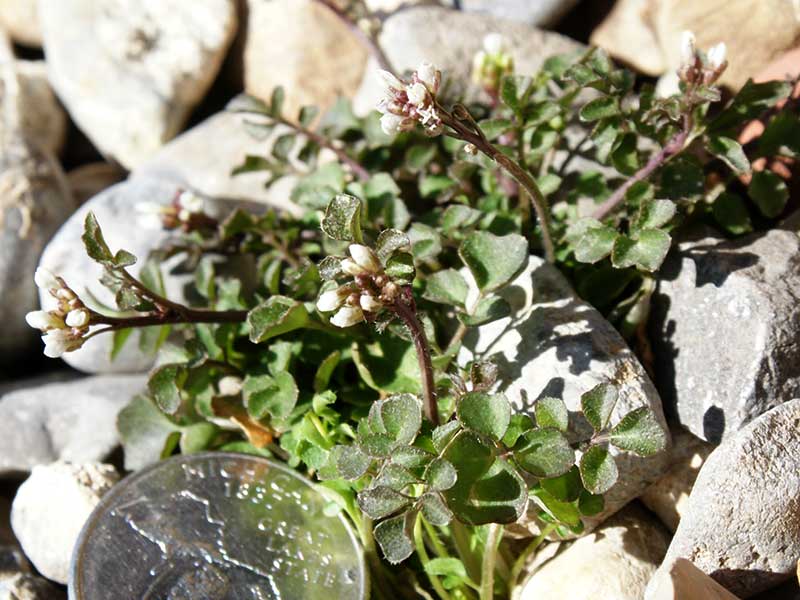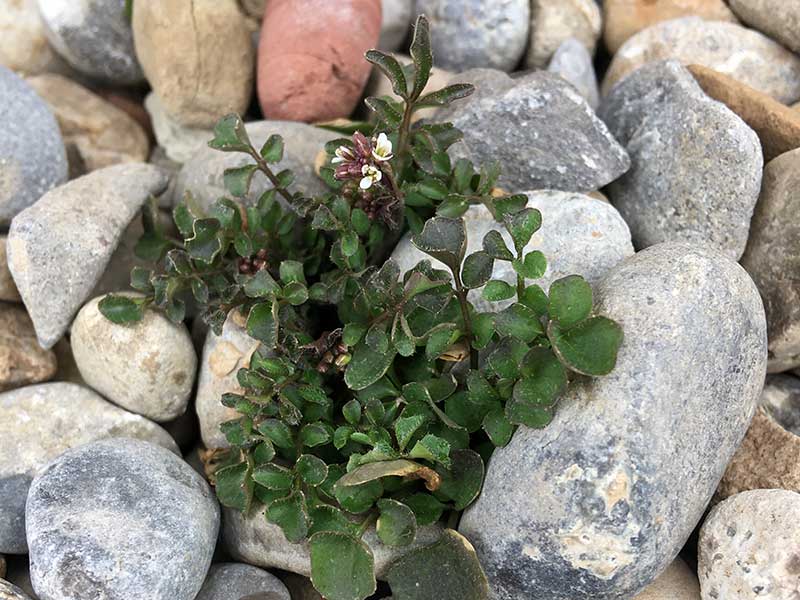Cardamine hirsute / hairy bittercress
- small brassica/crucifer with compound leaves
- teeny white, 4 petal flowers with 4 stamens in racemic clumps
- a widespread weed, including gardens and lawns
Also known as (but not uniquely): lamb’s cress, landcress, hoary bittercress, springcress, flickweed, and shotweed
Hairy bittercress is yet another of those small brassicas that most people would actually have no interest in actually identifying. It is a weed and not, at first site, a very interesting one at that. But you are likely to see it because it starts growing in the early spring and can keep it up for much of the year. In fact, it can overwinter green before flowering yet again in early spring.
So if you did want to identify it, here’s what you might look for. First, assuming there are flowers, they are teeny and white with four petals… a big yawn since there are so many brassicas like that. They may be as much as a foot tall, and in racemic clusters. But look closely and you will see that this one has only four stamens rather than six. Aha! And assuming it might also be fruiting, the siliques are straight, upright (unusual), reminiscent of toothpicks, and purple. Both flowers and siliques are likely to be present at the same time.
And if you’re lucky and the fruits are ripe and you want some fun, if you touch the siliques, they will burst open explosively, tossing the seeds some distance from the plant. This has a name… ballochory. The two sides of the silique will end up coiled tightly. Sorry, I don’t have photos of that yet.
If it is not in flower, hairy bittercress grows as a rosette of leaves, each divided pinnately into 8-15 leaflets, and each with a short petiolule (a leaflet equivalent of a petiole). They are round-ish in shape with either smooth or dentate edges. The terminal leaflet is the largest. Sometimes, there are also leaves on the flowering stalks. These have fewer leaflets and are smaller. As the name suggests, the stems, petioles and upper leaf surfaces are a bit hairy (but rather sparsely, not silvery dense).
As for habitat, hairy bittercress is usually in damp, recently disturbed soils, or on open ground, in lawns, or in “waste places.” Mostly, this will include your lawns and gardens. If you irrigate, it will grow.
Interesting bits – Despite my deprecating comments, hairy bittercress is actually a favorite weed for foragers. As the Brooklyn Botanical Garden explains, despite the name, its tender greens are edible. Their flavor is mild and peppery, not bitter. The leaves are “suitable for a chic microgreens salad and have tons of vitamin C, calcium, magnesium, beta-carotene, and antioxidants.” Despite my normal warnings about not putting things in your mouth that your mother didn’t OK, this one would work.
OK, once established, because of its many seeds, it is hard to eradicate. But it is also easy to pull, and if you do pull some from your garden beds, consider making a farmer’s sandwich of cheese, apples, and a bit of fresh bittercress. “Skip the compost pile and send it your stomach instead!”
And from Plant-Lore: During World War II, in Britain, hairy bittercress was one of several wild plants used in salads and cooking when more usual vegetables were not available. Others included watercress, stinging nettle, groundsel, saltwort and dandelion.
And weirder bits, also in parts of Britain, the local name for hairy bittercress was Jumping Jesus, but I have no idea why.
Finally, bittercress in Saxon lore was said to drive out venom and remove pain. Don’t count on this. So although you may safely put it in your mouth, don’t reach for it as your first choice in case of snake bite.
| Color | |
|---|---|
| Family | |
| Blossom size | |
| Inflorescence size | |
| Inflorescence type | |
| When? | |
| Where? |


